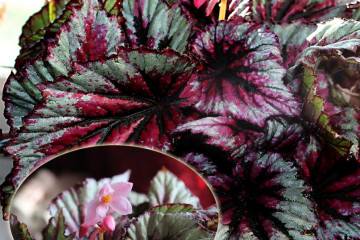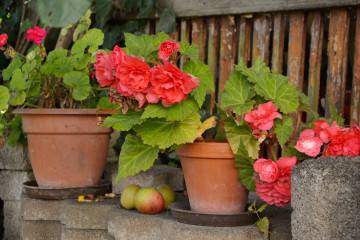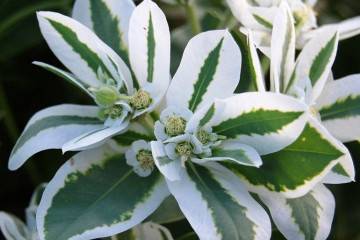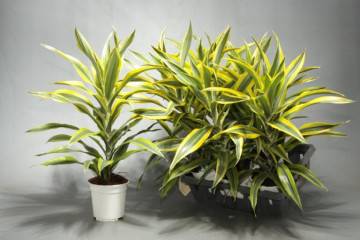Begonia Ornamental-leafy - cultivation features
Content:
Begonia (begonia) is a very common houseplant, which has also become a garden culture. There are many varieties of begonias. Below is written about what it is - leaf begonia, home care for which is not the easiest.
What does decorative leaf begonia look like, which family does it belong to?
Decorative-leaved begonias belong to the Begoniaceae family, which includes 1600 plant species. Its stems can be seen weaving along the ground, in the form of high and low shrubs. Its root system can be branched, fibrous and tuberous.
The leaf of decorative leaf begonia can be of different shapes. The upper part of the leaf can be either green or other shades, and the lower part in most cases is painted in colors with a reddish tint. The sheet can contain various curly patterns.
Decorative-leaved begonia consists of a large number of small, medium and large flowers. They come in a variety of colors, solid or with multi-colored edging around the edges.
Flowering occurs in the spring and summer.
Decorative foliage begonia: varieties
As already mentioned, there are thousands of varieties of this flower. However, there are some of the most famous varieties grown by both amateur and professional gardeners. Decorative deciduous begonia, varieties:
- royal;
- salty;
- hogweed;
- castor-leaved;
- griffith;
- Masson;
- begonia maple leaf.
Healing properties
The plant contains many useful substances, therefore it has a beneficial effect on the environment and on the human body.
Beneficial features:
- air purification from bacteria and dust;
- air humidification;
- increased immunity in humans;
- increased efficiency;
- relieves fatigue and nervous tension;
- has a beneficial effect on the work of the brain;
- promotes wound healing.
Briefly about the history of appearance
Begonia was found during an expedition led by the Governor of Haiti. It happened in 1687. Seven species of similar plants were found, which were named after the governor. His name was Michelle Begon.
Begonia came to Russia even during the reign of Peter the Great. She was brought in with other varieties of plants.
Decorative deciduous begonias: care and cultivation at home
Like every plant, decorative leaf begonia has some subtleties in care. How to care for a flower is described below.
Priming
The first thing you pay attention to is the ground. The soil should be soft and rich in minerals. For planting, leafy earth is taken mixed with fertilizers. Perlite can be added for better growth.
Temperature
The temperature at which the plant will feel comfortable varies from 18 to 25 degrees.
Lighting
Light intake should be moderate. In bright sunlight, the leaves will suffer from burns. And if there is insufficient light, growth will be slowed down.
Watering
Watering is carried out with boiled water on dry soil. For begonias, less water is better than excess.
Spraying
It is not recommended to spray the plant. For a normal amount of moisture, a container with water is placed next to the flower.
Humidity
The plant needs moderate moisture. Excess moisture will lead to root rot.
Top dressing
The flower needs feeding every three weeks. Fertilizers need to be taken organic and saturated with minerals. Also in gardening stores you can find special fertilizers that speed up the growth of plants.
Features of care in winter, dormant period
As you know, in winter, almost all plants go into dormancy. For a safe sleep in winter, you need to take the following measures to care for begonia:
- reduce watering;
- provide the plant with a sufficient amount of light, put it to the window or use additional lighting in the form of a lamp;
- monitor the temperature, it should not be below +18 degrees;
- remove the flower from hot batteries so that it does not overheat.
When and how it blooms
Flowering in favorable conditions begins in late spring or early summer and ends in early autumn. When blooming, bright flowers bloom, similar to the petals of roses or carnations. The color of flowers can be of different shades: both bright and pale colors.
Pruning
Pruning usually occurs in the spring, before or with transplanting. In the process of pruning, old stems and those that have elongated are removed.
How decorative leaf begonia reproduces
This plant propagates in three ways: by seeds, cuttings, separation of bushes.
Germinating seeds
Seed propagation stages:
- planting seeds in potting soil;
- cover and put in a warm place;
- watered, but not abundantly;
- sprouted shoots (they will germinate within two weeks) are planted in separate containers;
- after a month, seedlings grown in suitable conditions can be transplanted into a pot.
Rooting cuttings
Stages of grafting:
- cut off the stalk, it must have buds;
- cut off extra leaves from it;
- after the cut dries up, it is treated with a product for better growth;
- plant a stalk and cover with a film;
- two weeks just watered and then watered along with the fertilizer.
Separation of bushes
Stages of reproduction by dividing the bushes:
- with a knife, carefully remove the plant from the pot;
- divide the root into several parts;
- the sections are treated with a growth solution;
- the resulting bushes are planted in pots in the soil mixture and watered.
Transfer
In spring, the land is renewed and transplanted. If the flower is placed in an old pot, then they are transplanted there, and if the roots are cramped, then they take a larger pot. Transplant stages:
- preparing a pot for transplant;
- drainage is poured to the bottom;
- carefully take out the plant;
- cleaning the roots;
- place a flower in a container;
- sprinkle with earth;
- watered.
Possible growing problems and diseases
All begonia diseases are mainly associated with insufficient care of the plant. Improper watering, high or low temperatures, lack or excess of moisture, all these factors lead to the fact that the plant is sick.
Pests
Basically, pests are dangerous for street begonias, but an insect can also enter the house, which will be dangerous for a houseplant. This can be, for example, aphids, ticks, whiteflies.
The above tips are relevant for the decorative leaf begonia flower, the care of which and growing at home will become more effective if you follow them. Such a plant can be grown at home if you follow the rules of caring for it.



















